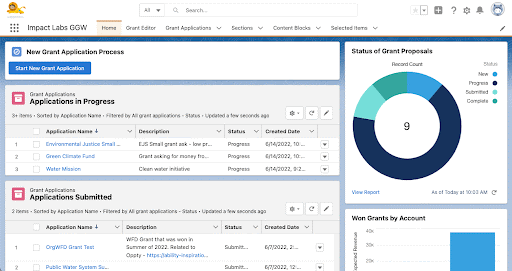Climate change is one of the most pressing issues of our time. The urgency around our climate is high, and the rallying cry is clear: We have to act. Now.
We responded by bringing together a wide range of climate and community experts through an Impact Lab on Climate Justice to explore areas where technology can have the most impact. Together, the Salesforce.org Impact Labs Community Fellows identified a few areas that need improvement: the first was ways to engage the community to ensure any solution would be sustainable, and the second was to improve the ability to get funding for climate organizations.
The cohort decided to focus on funding because climate action is significantly underfunded — especially compared to the size of the problem — and the challenge is pervasive across climate community-based organizations (CBOs). Climate change puts pressure on every aspect of our society, putting philanthropic efforts towards other causes at risk, yet funding remains sparse in comparison.
Philanthropy, particularly from companies that are investing significantly in getting to net zero, is a powerful, yet currently underutilized tool to enhance, scale, and amplify the impact of the work being done by climate-focused organizations.
Earlier this year, the cohort released their three principles for engaging communities, and now we’re excited to announce the launch of the Grant Content Kit, which will enable these organizations to more quickly apply for funding.
I wanted to hear more about the Impact Labs experience and product directly from our cohort, so I sat down with Clayton Aldern, Senior Data Reporter at Grist, to get his take on the crisis we’re facing, the needs surrounding it, and the solution he and the cohort designed.
Stephanie Zeitz (SZ): Why is the conversation around climate justice so critical today?
Clayton Aldern (CA): Climate justice is really the only conversation that matters in climate policy. If you’re not working toward climate justice, you’re probably not working toward the necessary structural change in the climate space.
First, the lens of climate justice offers an opportunity to address historical injustice in environmental exposures and the energy sector. Second, if we design climate solutions for and with those communities most affected by it — often highly disadvantaged and underserved communities — it often means we can get to the root of the problem, with knock-on benefits for everyone.
SZ: Even though this is a critical issue, there are a lot of roadblocks regarding climate justice. What is hindering its advancements [that can be helped by technology]?
CA: Money. Political will. Structural racism. The usual stuff! Advancing climate justice implies working from a place of inclusivity, solidarity and mutuality. Unfortunately, a lot of contemporary institutions — including those in the technology space — just aren’t set up in a manner that caters to these principles. We all know that technology alone won’t solve the climate (justice) crisis, but when it can be leveraged for democratic organizing, it can help move the needle.
SZ: So, what came out of this Impact Labs? What tool or resource did you develop?
CA: We created a tool called Grants Content Kit. It’s designed to help climate focused CBOs write award-winning grants more effectively, thereby moving money in the right direction. The solution is a set of modules that allows these organizations to quickly assemble applications for philanthropic support. It allows you to tag paragraphs, sections, and charts with labels that correspond to the type of project, philanthropic opportunity, and — post-submission — degree of success. You can then recycle and edit relevant tagged sections for future applications.

SZ: Can you tell us why your cohort decided to focus on grant writing?
CA: Much of our initial work focused on a reformulation of the problem statement. Climate and environmental justice felt too place-based and context-specific to benefit from a single technological solution. However, we did recognize that the flow of capital enables a lot of this work. So, instead, we started thinking about the back offices of small CBOs working on environmental justice and wondered if there might be a technological contribution that could better position such groups to access these philanthropic flows.
Much of the following work took the form of interviews with CBOs and subsequent design workshops with community fellows and pro bono volunteers. This all became centered on the development of a tool that might contribute to the access of funding.
SZ: What makes this solution so innovative? How will it help the advancement of climate justice?
CA: Accessing capital is harder than it ought to be for frontline CBOs. Many of these groups don’t have a full-time development team, or even a staffer to dedicate their time to applying for funding.
I’ve worked as a nonprofit development professional, and I know how frustrating it can be to start each grant application or foundation report from scratch. It can feel like this even if you have a great filing system and can draw from past efforts, because each application requires something a little bit different.
Hopefully, availability of these modules can reduce the friction of requests for support so people can spend less time applying for grants and more time doing the work.
SZ: Where do you hope to see this solution go in the future?
CA: I’d love to see Salesforce make it and any software prerequisites freely available to organizations working on climate and environmental justice. Ideally, this would include any necessary training to ensure it’s adopted. I think the risk of these kinds of efforts is always with respect to adoption, and I’m hopeful that this tool will indeed end up in the right hands.
SZ: What is something you hope others take away from this work and what your cohort released?
CA: That there is still a lot of work to be done, and that the grounding principles of working directly with communities is critical to progress. A set of grant application modules isn’t going to solve the climate crisis, nor is it going to correct for historical climate and environmental injustice. I think this work is a positive step toward lowering some of the capital barriers in question.
However, it’s important to remember that this isn’t the same as structural change. For example, it still accepts the premise of this mode of philanthropy being the most appropriate path toward climate solutions. That might be a flawed premise! It’s essential we keep foregrounding principles of democratic organizing if we’re going to expect any substantive progress toward climate justice.
Join the Grants Content Kit Trailblazer Community Group
Learn more about the solution and discover ways you can contribute to it at an upcoming Open Source Commons Community Sprint.



How to Access the Grants Content Kit
I couldn’t agree more with Clayton that there is still so much work to be done. At Salesforce.org, we’re humbled by the organizations that we get to partner with as we work together as a community to find solutions that help accelerate progress toward protecting our climate for future generations. We know that technology cannot solve the world’s problems, but we also know we cannot make progress without it. That’s why we’re honored to be the platform on which products like the Grant Content Kit are built, and remain open source so that the community can continue to develop it to its full potential.
Team Earth has landed
We believe that business is the greatest platform for change, and success should be for everyone on Earth and the planet itself. Because the new frontier? It’s right here.

































